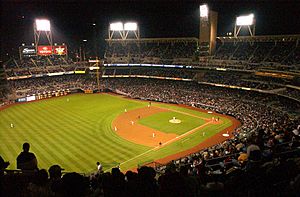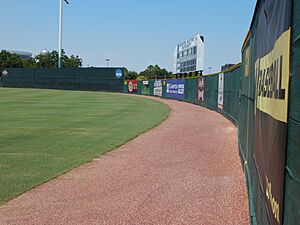Baseball field facts for kids
A baseball field, also called a ball field or baseball diamond, is the special area where the game of baseball is played. Sometimes, people use "baseball field" to mean the whole baseball park where games happen. You might also hear the word sandlot, but this usually means a less organized place where kids play casual games.
Contents
How a Baseball Field is Set Up
The most important part of the field is home plate (also called "home base"). It's a five-sided piece of white rubber. One side is 17 inches (43 cm) long. Two sides next to it are 8.5 inches (22 cm) long. The last two sides are about 12 inches (30 cm) long and form a right angle. Home plate is flat with the ground.
The corner of home plate where the two 12-inch sides meet is one corner of a 90-foot (27 m) square. The other three corners of this square are first, second, and third base. These bases are marked by soft bags, 18 inches (46 cm) square and 3 to 5 inches (8 to 13 cm) thick. Next to home plate are the batter's boxes.
All the bases, including home plate, are in fair territory. This means if a batted ball touches any base, it's a fair ball. First and third base bags are inside the 90-foot square. Second base is placed so its center is exactly at the corner of the square. So, while the "points" of the bases are 90 feet apart, the actual distance between the bags is closer to 88 feet (27 m).
Near the middle of the square is a small hill called the pitcher's mound. On top of the mound is a white rubber slab called the pitcher's plate, or "the rubber."
Lines run from home plate to first base and from home plate to third base. These are called the foul lines. They go all the way to the outfield fence. The part of the field between (and including) these foul lines is called fair territory. Everything else is foul territory.
The area inside the square formed by the bases is the infield. The area outside the infield, but still in fair territory, is the outfield. Most baseball fields have a fence around the outfield. This fence is usually 300 to 420 feet (91 to 128 m) from home plate. Most professional fields also have foul poles at the ends of the outfield fence. These poles are in fair territory. If a batted ball flies over the outfield wall and touches a foul pole, it's a home run.
The Infield
The infield is the square area inside the four 90-foot baselines. For younger players in Little League Baseball, the baselines are 60 feet (18 m). The four bases are part of the infield. If a ball touches any part of a base, it's a fair ball.
The Bases
First Base

First base is the first base a runner must touch to score a run. A runner can keep running past first base in a straight line without being tagged out, as long as they touch the base and don't try to go to second base.
The first baseman is the player who defends the area near first base. Some youth leagues use a "double first base" or "safety first base." This base is 30 by 15 inches (76 by 38 cm) and has a white half and an orange half. The white half is for the first baseman, and the orange half is for the runner. This helps prevent injuries.
In baseball scorekeeping, the first baseman is number 3.
Second Base
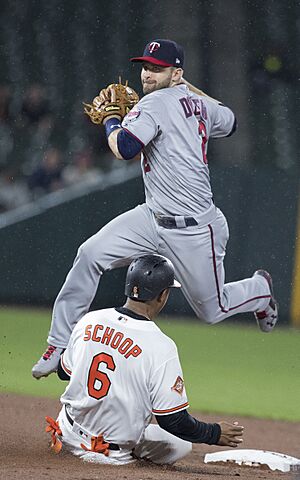
Second base is the second base a runner must touch. The second baseman and the shortstop usually defend second base. These players need to be fast and throw the ball quickly and accurately. They work together to make a double play.
A runner on second base is in "scoring position." This means they have a good chance of scoring a run if another player hits the ball. Second base is the farthest from home plate, so it's the most common base to steal.
The second baseman is number 4, and the shortstop is number 6.
Third Base
Third base is the third base a runner must touch. The third baseman defends the area near third base. A good third baseman reacts quickly to batted balls and has a strong arm to throw to first base. Third base is sometimes called the "hot corner" because right-handed batters often hit hard balls there, making it tough and sometimes dangerous to field. The third baseman is number 5.
Like a runner on second base, a runner on third base is in "scoring position." They have a good chance of scoring on a single hit or a sacrifice fly.
Home Base
Home base, or "home plate," is the last base a player must touch to score a run. It's different from the other bases because it's a five-sided piece of white rubber set flat with the ground.
Backstop
Most professional baseball stadiums have a backstop at least 60 feet (18 m) behind home plate. It's a wall and netting that protects fans from wild pitches, passed balls, and foul balls.
In local fields, there's usually a tall fence around the infield and player benches for safety.
Baselines
Baselines are straight lines between two bases, usually marked with chalk. There are no physical lines between first and second, or second and third bases. The foul lines mark the baselines between home plate and first base, and between third base and home.
Running Baseline
Runners don't have to run exactly on the baseline. They often "round" the bases in a curve. But if a fielder tries to tag a runner, the runner's path becomes a straight line to the next base. If a runner goes more than 3 feet (0.9 m) away from this line to avoid a tag, they can be called out.
Running Lane
Between home plate and first base, there's a second chalk line to the right of the foul line. This line and the foul line create a "running lane." A batter running to first base must stay in this lane. If they run outside the lane and get in the way of a fielder trying to throw to first, the batter is out. They can leave the lane right at first base to step on it.
Areas Near Home Plate
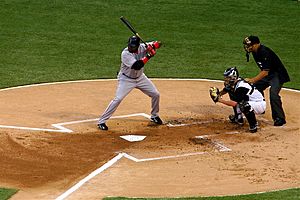
Batter's Box
The batter's box is where the batter stands to hit the ball. It's usually drawn with chalk on the dirt around home plate.
There are two batter's boxes, one on each side of home plate. They are 4 feet (1.2 m) wide and 6 feet (1.8 m) long. They are centered with home plate. A right-handed batter stands on the right side, and a left-handed batter stands on the left. A batter cannot leave the box once the pitcher starts to throw the ball without asking the umpire for a time-out.
Catcher's Box
The catcher's box is the area behind home plate where the catcher stands. This helps the catcher avoid certain rule violations when a pitch is thrown.
Pitcher's Mound
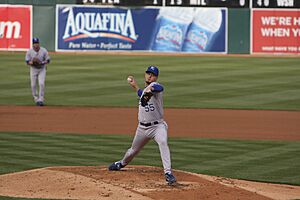
The pitcher's mound is a low hill in the middle of the infield. This is where the pitcher stands to throw the ball. On top of the mound is the pitcher's plate, a white rubber slab. It is 6 inches (15 cm) from front to back and 2 feet (61 cm) across. The front of this plate is exactly 60 feet 6 inches (18.44 m) from the back point of home plate. This specific distance was set in 1893.
In Major League Baseball, a mound is 18 feet (5.5 m) wide. The front edge of the pitcher's plate is 60 feet 6 inches from home plate. The top of the rubber cannot be more than 10 inches (25 cm) higher than home plate. From 1903 to 1968, this height limit was 15 inches (38 cm).
A higher mound generally helps the pitcher. It gives them more power to throw the ball downwards, making it harder for the batter to hit. After the 1968 season, which was known as "the year of the pitcher" because pitchers were so dominant, the mound height was lowered from 15 to 10 inches. This was done to help batters hit more often.
Groundskeepers work hard to keep the pitcher's mound in good shape. Pitchers can also keep a rosin bag on the back of the mound to dry their hands.
The Grass Line
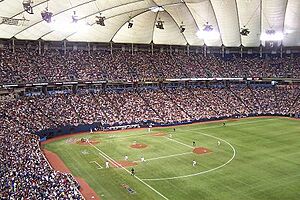
The grass line is where the dirt of the infield meets the grass of the outfield. This line doesn't have special rules, but it helps players and umpires see distances better. Sometimes, a ball can bounce in a tricky way off the dirt or the edge of the grass. Some important games, like the World Series, have been affected by these unusual bounces.
In stadiums with artificial turf, the infield used to have dirt only around the bases and the pitcher's and batting areas. The "grass line" was often a white arc. Today, most major league fields with artificial turf have a full dirt infield. Some college fields might even have clay-colored turf instead of real dirt.
The Outfield
The outfield is made of thick grass or artificial turf. This is where the outfielders play: left, center, and right field. The outfield's size and shape can change depending on the field. It stretches from the infield to the outfield wall and includes the warning track. Outfields in Little League can be very different in size compared to major league fields.
Warning Track
The warning track is a strip of dirt around the edges of the outfield, especially in front of the home run fence. It's a different color and feel from the grass. This helps fielders know they are getting close to the fence without having to look away from the ball.
The rules don't say how wide the warning track must be. It's usually wide enough to give players about three steps of warning. For professional fields, it's often 10 to 15 feet (3.0 to 4.6 m) wide. This width also helps groundskeepers avoid driving their vehicles on the grass.
The idea for the warning track started at Yankee Stadium. It had a running track for other sports. When people saw how it helped baseball fielders, it became a standard part of every ballpark.
Sometimes, fielders still crash into the wall even with the warning track. That's why outfield walls are usually padded for safety.
Outfield Wall

The outfield wall or fence is the outer edge of the outfield. If a ball goes over the wall, it's a "dead ball." If it goes over the wall in fair territory without touching the ground, it's a home run. The rules don't say how tall or what material the wall should be, or its exact distance from home plate. However, Major League Baseball suggests a minimum distance of 320 feet (98 m) at the foul poles and 400 feet (122 m) in center field.
Because of this, baseball fields can look very different. Most modern professional walls are made of a hard material with padding to protect players. Some parts might have chain-link fencing if transparency is needed, like for a bullpen or a scoreboard. Many ballparks have a yellow line at the top of the wall to help umpires decide if a ball is a home run.
Foul Poles
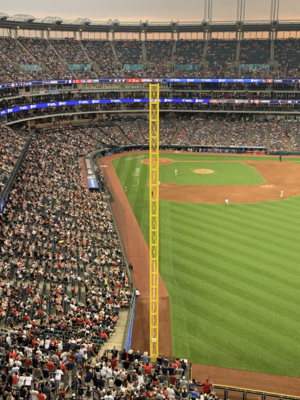
Foul poles help umpires decide if a fly ball hit over the fence is foul (out of play) or fair (a home run). The poles are vertical extensions of the foul lines. The outer edge of the foul lines and foul poles mark foul territory. Both the lines and the poles are actually in fair territory. The minimum distance for a home run along the foul line is usually 325 feet (99 m).
Before 1931, a home run was only counted if the ball landed in fair territory outside the field. Now, a ball is judged fair or foul at the point it leaves the field. So, if a ball passes on the fair side of a foul pole, or hits a foul pole, it's a home run.
Foul poles are usually much taller than the outfield fence. They often have a narrow screen on the fair side to help umpires even more. It can still be a tough call, especially in ballparks without stands behind the poles.
In Major League Baseball, foul poles are usually yellow.
Player Areas
Bullpen
The bullpen is where pitchers warm up before they enter a game. It might be along the baselines or just beyond the outfield fence. Relief pitchers wait here instead of in the dugout. The starting pitcher also does their final warmups here. Managers can call coaches in the bullpen to tell a pitcher to start warming up.
"Bullpen" is also used to describe all the relief pitchers on a team.
On-Deck Circles
There are two on-deck circles, one for each team. They are in foul territory between home plate and the team's bench. The on-deck circle is where the next batter warms up while waiting for their turn. It can be a dirt circle, a painted circle on turf, or a special mat with a team logo.
Coach's Boxes
The coach's boxes are located behind first and third base. This is where the first and third base coaches stand. Coaches can sometimes stand outside the box, as long as they don't get in the way of the game and the other team doesn't complain. The boxes are marked with chalk or paint.
History of the Field
The basic design of the baseball field hasn't changed much since the 1840s. The distance between bases was first officially set at 90 feet (27 m) in 1857. People found that 90 feet was the best distance. If it was 100 feet, it would be too easy for the defense. If it was 80 feet, it would be too easy for the offense.
In the early days, pitchers threw from a "box" 45 feet (14 m) from home plate. They had to throw underhand. By the 1880s, pitchers were very good at underhand throwing.
Modern History
To help batters hit more, the pitcher's box was moved back 5 feet (1.5 m) in 1881, making it 50 feet (15 m) from home plate. In 1884, pitchers were allowed to throw overhand, which again gave them an advantage.
In 1893, the pitcher's box was replaced by the pitcher's plate. The distance the pitcher had to stand was increased by 5 feet, making the pitching distance 60 feet 6 inches (18.44 m). This was done to "increase the batting" and make the game more exciting for fans.
Originally, pitchers threw from flat ground. Over time, the raised mound was developed, which helped pitchers again. From 1893 to 1950, the mound could be no more than 15 inches (38 cm) above the field. Before the mid-1900s, many fields had a dirt path between the pitcher's mound and home plate, sometimes called a "keyhole." This path became less common and was mostly removed by the 1950s. Today, some ballparks bring it back for a nostalgic look.
Home plate was originally a circular iron plate, then a 12-inch (30 cm) square. The five-sided rubber plate we see today was adopted in 1900.
There were no batter's boxes before 1874. Batters had to hit with their front foot on a line through the center of the plate. The modern batter's box size (6 by 4 feet or 1.8 by 1.2 m) was set in 1885.
Awards for Field Maintenance
The Sports Turf Managers Association (STMA) gives out awards each year. Since 2001, they have given "Sports Turf Manager of the Year Awards" to people who keep the fields in great shape for different levels of Minor League Baseball. STMA also gives a "Baseball Field of the Year Award" for schools, parks, colleges, and professional fields.
See also
 In Spanish: Campo de béisbol para niños
In Spanish: Campo de béisbol para niños
- Official Rules of Major League Baseball
- Softball field


